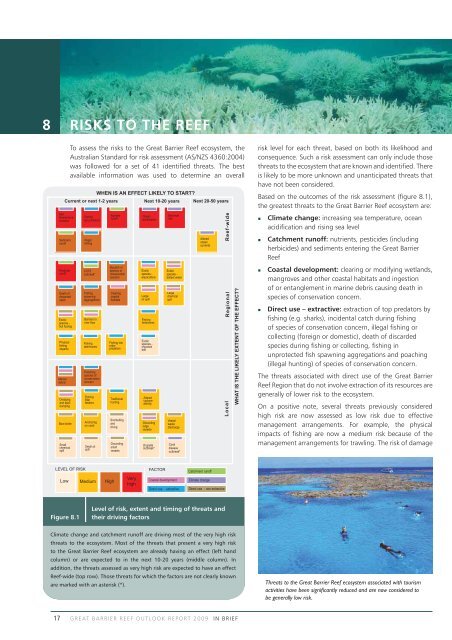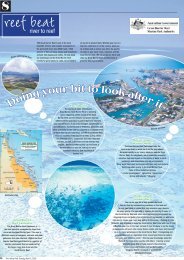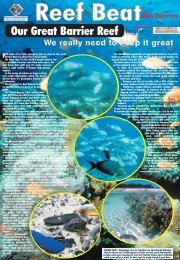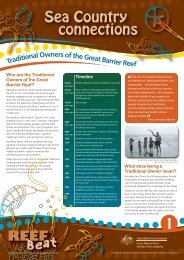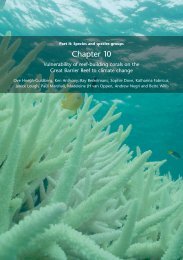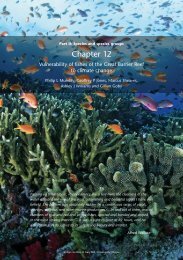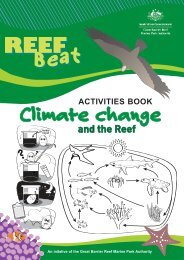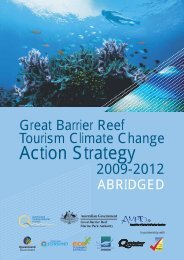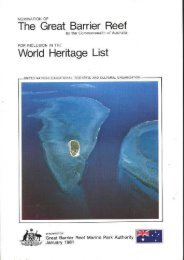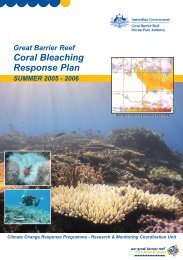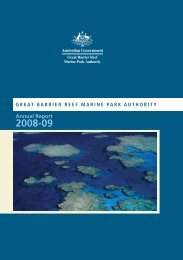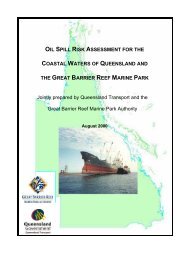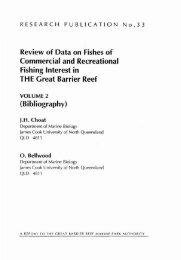Great Barrier Reef Outlook Report 2009 â In Brief
Great Barrier Reef Outlook Report 2009 â In Brief
Great Barrier Reef Outlook Report 2009 â In Brief
- No tags were found...
You also want an ePaper? Increase the reach of your titles
YUMPU automatically turns print PDFs into web optimized ePapers that Google loves.
8RISKS TO THE REEFTo assess the risks to the <strong>Great</strong> <strong>Barrier</strong> <strong>Reef</strong> ecosystem, theAustralian Standard for risk assessment (AS/NZS 4360:2004)was followed for a set of 41 identified threats. The bestavailable information was used to determine an overallWHEN IS AN EFFECT LIKELY TO START?Current or next 1-2 years Next 10-20 years Next 20-50 yearsSeatemperatureincreaseSedimentrunoffPesticiderunoffDeath ofdiscardedcatchExoticspecies -hull foulingPhysicalfishingimpactsMarinedebrisDredgingand spoildumpingBoat strikeSmallchemicalspillFishingtop predatorsIllegalfishingCOTSoutbreak*Fishingspawningaggregations<strong>Barrier</strong>s toriver flowFishingdetritivoresPoachingspecies ofconservationconcernFishingfilterfeedersAnchoringon coralSmall oilspillNutrientrunoffBycatch ofspecies ofconservationconcernClearingcoastalhabitatsFishing loworderpredatorsTraditionalhuntingSnorkellinganddivingGroundingsmallvesselsOceanacidificationExoticspecies -aquacultureLargeoil spillFishingherbivoresExoticspecies -importedbaitAlteredcycloneactivityGroundinglargevesselsDrupellaoutbreak*Sea levelriseExoticspecies -ballast waterLargechemicalspillVesselwastedischargeCoraldiseaseoutbreak*AlteredoceancurrentsLocal Regional <strong>Reef</strong>-wideWHAT IS THE LIKELY EXTENT OF THE EFFECT?risk level for each threat, based on both its likelihood andconsequence. Such a risk assessment can only include thosethreats to the ecosystem that are known and identified. Thereis likely to be more unknown and unanticipated threats thathave not been considered.Based on the outcomes of the risk assessment (figure 8.1),the greatest threats to the <strong>Great</strong> <strong>Barrier</strong> <strong>Reef</strong> ecosystem are:Climate change: increasing sea temperature, oceanacidification and rising sea levelCatchment runoff: nutrients, pesticides (includingherbicides) and sediments entering the <strong>Great</strong> <strong>Barrier</strong><strong>Reef</strong>Coastal development: clearing or modifying wetlands,mangroves and other coastal habitats and ingestionof or entanglement in marine debris causing death inspecies of conservation concern.Direct use – extractive: extraction of top predators byfishing (e.g. sharks), incidental catch during fishingof species of conservation concern, illegal fishing orcollecting (foreign or domestic), death of discardedspecies during fishing or collecting, fishing inunprotected fish spawning aggregations and poaching(illegal hunting) of species of conservation concern.The threats associated with direct use of the <strong>Great</strong> <strong>Barrier</strong><strong>Reef</strong> Region that do not involve extraction of its resources aregenerally of lower risk to the ecosystem.On a positive note, several threats previously consideredhigh risk are now assessed as low risk due to effectivemanagement arrangements. For example, the physicalimpacts of fishing are now a medium risk because of themanagement arrangements for trawling. The risk of damageLEVEL OF RISKLowMediumHighVeryhighFACTORCoastal developmentDirect use - extractiveCatchment runoffClimate changeDirect use - non-extractiveFigure 8.1Level of risk, extent and timing of threats andtheir driving factorsClimate change and catchment runoff are driving most of the very high riskthreats to the ecosystem. Most of the threats that present a very high riskto the <strong>Great</strong> <strong>Barrier</strong> <strong>Reef</strong> ecosystem are already having an effect (left handcolumn) or are expected to in the next 10-20 years (middle column). <strong>In</strong>addition, the threats assessed as very high risk are expected to have an effect<strong>Reef</strong>-wide (top row). Those threats for which the factors are not clearly knownare marked with an asterisk (*).Threats to the <strong>Great</strong> <strong>Barrier</strong> <strong>Reef</strong> ecosystem associated with tourismactivities have been signi cantly reduced and are now considered tobe generally low risk.17GREAT BARRIER REEF OUTLOOK REPORT <strong>2009</strong> IN BRIEF


